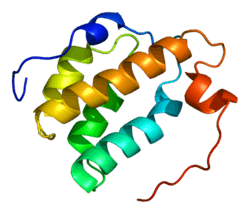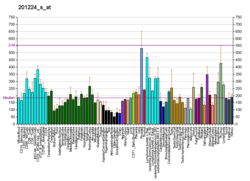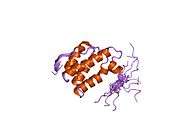SRRM1
Serine/arginine repetitive matrix protein 1 is a protein that in humans is encoded by the SRRM1 gene.[3][4]
Interactions
References
- 1 2 3 GRCh38: Ensembl release 89: ENSG00000133226 - Ensembl, May 2017
- ↑ "Human PubMed Reference:".
- ↑ Blencowe BJ, Issner R, Nickerson JA, Sharp PA (May 1998). "A coactivator of pre-mRNA splicing". Genes Dev. 12 (7): 996–1009. doi:10.1101/gad.12.7.996. PMC 316672. PMID 9531537.
- ↑ "Entrez Gene: SRRM1 serine/arginine repetitive matrix 1".
- ↑ Ajuh P, Kuster B, Panov K, Zomerdijk JC, Mann M, Lamond AI (December 2000). "Functional analysis of the human CDC5L complex and identification of its components by mass spectrometry". EMBO J. 19 (23): 6569–81. doi:10.1093/emboj/19.23.6569. PMC 305846. PMID 11101529.
Further reading
- Wang HY, Lin W, Dyck JA, Yeakley JM, Songyang Z, Cantley LC, Fu XD (1998). "SRPK2: a differentially expressed SR protein-specific kinase involved in mediating the interaction and localization of pre-mRNA splicing factors in mammalian cells". J. Cell Biol. 140 (4): 737–50. doi:10.1083/jcb.140.4.737. PMC 2141757. PMID 9472028.
- Wilson KF, Fortes P, Singh US, Ohno M, Mattaj IW, Cerione RA (1999). "The nuclear cap-binding complex is a novel target of growth factor receptor-coupled signal transduction". J. Biol. Chem. 274 (7): 4166–73. doi:10.1074/jbc.274.7.4166. PMID 9933612.
- Eldridge AG, Li Y, Sharp PA, Blencowe BJ (1999). "The SRm160/300 splicing coactivator is required for exon-enhancer function". Proc. Natl. Acad. Sci. U.S.A. 96 (11): 6125–30. doi:10.1073/pnas.96.11.6125. PMC 26846. PMID 10339552.
- Blencowe BJ, Baurén G, Eldridge AG, Issner R, Nickerson JA, Rosonina E, Sharp PA (2000). "The SRm160/300 splicing coactivator subunits". RNA. 6 (1): 111–20. doi:10.1017/S1355838200991982. PMC 1369899. PMID 10668804.
- Le Hir H, Moore MJ, Maquat LE (2000). "Pre-mRNA splicing alters mRNP composition: evidence for stable association of proteins at exon-exon junctions". Genes Dev. 14 (9): 1098–108. PMC 316578. PMID 10809668.
- McGarvey T, Rosonina E, McCracken S, Li Q, Arnaout R, Mientjes E, Nickerson JA, Awrey D, Greenblatt J, Grosveld G, Blencowe BJ (2000). "The acute myeloid leukemia-associated protein, DEK, forms a splicing-dependent interaction with exon-product complexes". J. Cell Biol. 150 (2): 309–20. doi:10.1083/jcb.150.2.309. PMC 2180225. PMID 10908574.
- Le Hir H, Izaurralde E, Maquat LE, Moore MJ (2000). "The spliceosome deposits multiple proteins 20-24 nucleotides upstream of mRNA exon-exon junctions". EMBO J. 19 (24): 6860–9. doi:10.1093/emboj/19.24.6860. PMC 305905. PMID 11118221.
- Lykke-Andersen J, Shu MD, Steitz JA (2001). "Communication of the position of exon-exon junctions to the mRNA surveillance machinery by the protein RNPS1". Science. 293 (5536): 1836–9. doi:10.1126/science.1062786. PMID 11546874.
- McCracken S, Lambermon M, Blencowe BJ (2002). "SRm160 splicing coactivator promotes transcript 3'-end cleavage". Mol. Cell. Biol. 22 (1): 148–60. doi:10.1128/MCB.22.1.148-160.2002. PMC 134228. PMID 11739730.
- Szymczyna BR, Pineda-Lucena A, Mills JL, Szyperski T, Arrowsmith CH (2002). "1H, 13C, and 15N resonance assignments and secondary structure of the PWI domain from SRm160 using reduced dimensionality NMR". J. Biomol. NMR. 22 (3): 299–300. doi:10.1023/A:1014904502424. PMID 11991360.
- Jurica MS, Licklider LJ, Gygi SR, Grigorieff N, Moore MJ (2002). "Purification and characterization of native spliceosomes suitable for three-dimensional structural analysis". RNA. 8 (4): 426–39. doi:10.1017/S1355838202021088. PMC 1370266. PMID 11991638.
- Lejeune F, Ishigaki Y, Li X, Maquat LE (2002). "The exon junction complex is detected on CBP80-bound but not eIF4E-bound mRNA in mammalian cells: dynamics of mRNP remodeling". EMBO J. 21 (13): 3536–45. doi:10.1093/emboj/cdf345. PMC 126094. PMID 12093754.
- Meissner M, Lopato S, Gotzmann J, Sauermann G, Barta A (2003). "Proto-oncoprotein TLS/FUS is associated to the nuclear matrix and complexed with splicing factors PTB, SRm160, and SR proteins". Exp. Cell Res. 283 (2): 184–95. doi:10.1016/S0014-4827(02)00046-0. PMID 12581738.
- Szymczyna BR, Bowman J, McCracken S, Pineda-Lucena A, Lu Y, Cox B, Lambermon M, Graveley BR, Arrowsmith CH, Blencowe BJ (2003). "Structure and function of the PWI motif: a novel nucleic acid-binding domain that facilitates pre-mRNA processing". Genes Dev. 17 (4): 461–75. doi:10.1101/gad.1060403. PMC 196000. PMID 12600940.
- Wagner S, Chiosea S, Nickerson JA (2003). "The spatial targeting and nuclear matrix binding domains of SRm160". Proc. Natl. Acad. Sci. U.S.A. 100 (6): 3269–74. doi:10.1073/pnas.0438055100. PMC 152281. PMID 12624182.
- McCracken S, Longman D, Johnstone IL, Cáceres JF, Blencowe BJ (2003). "An evolutionarily conserved role for SRm160 in 3'-end processing that functions independently of exon junction complex formation". J. Biol. Chem. 278 (45): 44153–60. doi:10.1074/jbc.M306856200. PMID 12944400.
- Wagner S, Chiosea S, Ivshina M, Nickerson JA (2004). "In vitro FRAP reveals the ATP-dependent nuclear mobilization of the exon junction complex protein SRm160". J. Cell Biol. 164 (6): 843–50. doi:10.1083/jcb.200307002. PMC 2172284. PMID 15024032.
- Brill LM, Salomon AR, Ficarro SB, Mukherji M, Stettler-Gill M, Peters EC (2004). "Robust phosphoproteomic profiling of tyrosine phosphorylation sites from human T cells using immobilized metal affinity chromatography and tandem mass spectrometry". Anal. Chem. 76 (10): 2763–72. doi:10.1021/ac035352d. PMID 15144186.
External links
- SRRM1 human gene location in the UCSC Genome Browser.
- SRRM1 human gene details in the UCSC Genome Browser.
This article is issued from
Wikipedia.
The text is licensed under Creative Commons - Attribution - Sharealike.
Additional terms may apply for the media files.





